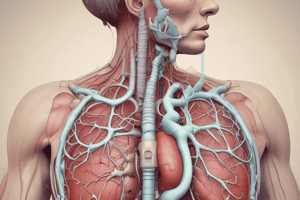Podcast
Questions and Answers
The primary function of pulmonary ventilation is the movement of air into and out of the ______.
The primary function of pulmonary ventilation is the movement of air into and out of the ______.
lungs
The ______ connects the nasal cavity and mouth to the larynx and esophagus.
The ______ connects the nasal cavity and mouth to the larynx and esophagus.
pharynx
The ______ serves as a switching mechanism to route food and air.
The ______ serves as a switching mechanism to route food and air.
larynx
The trachea is lined with pseudostratified ciliated columnar ______.
The trachea is lined with pseudostratified ciliated columnar ______.
The last tracheal cartilage, known as the ______, functions in cough reflex.
The last tracheal cartilage, known as the ______, functions in cough reflex.
The ______ tree is the site where conducting zone structures transition to the respiratory zone structures.
The ______ tree is the site where conducting zone structures transition to the respiratory zone structures.
Alveoli are composed of simple squamous ______.
Alveoli are composed of simple squamous ______.
The ______ provides an airway for respiration and warms and moistens entering air.
The ______ provides an airway for respiration and warms and moistens entering air.
The wall of the nasal cavity is divided by a midline structure called the ______.
The wall of the nasal cavity is divided by a midline structure called the ______.
The ______ bone forms the bridge of the nose.
The ______ bone forms the bridge of the nose.
The ______ sinus is one of a pair of air-filled cavities in the frontal bone.
The ______ sinus is one of a pair of air-filled cavities in the frontal bone.
The ______ palate is formed by maxillary and palatine bones.
The ______ palate is formed by maxillary and palatine bones.
The ______ or external nares is where air enters the nasal cavity.
The ______ or external nares is where air enters the nasal cavity.
The ______ occupies all of the thoracic cavity except the mediastinum.
The ______ occupies all of the thoracic cavity except the mediastinum.
The ______ epithelium located in the roof of the nasal cavity intensifies the sense of smell.
The ______ epithelium located in the roof of the nasal cavity intensifies the sense of smell.
Flashcards are hidden until you start studying
Study Notes
Respiratory System Overview
- Functions include pulmonary ventilation, external respiration, transport of respiratory gases, and internal respiration.
- Pulmonary ventilation: Movement of air in and out of the lungs.
- External respiration: Exchange of O2 from lungs to blood and CO2 from blood to lungs.
- Transport of respiratory gases is facilitated by the cardiovascular system using blood.
- Internal respiration: Transfer of O2 from blood to tissues and CO2 from tissues to blood.
Nose Structure
- Divided into the external nose (nostrils or nares) and the nasal cavity (posterior to the external nose).
- Functions:
- Provides airway for respiration.
- Moistens and warms inhaled air.
- Filters and cleans inspired air.
- Acts as a resonating chamber for speech.
- Houses olfactory receptors.
Nasal Cavity
- Air enters through the nostrils and is divided by the nasal septum, comprised of the perpendicular plate of the ethmoid bone, vomer, and cartilage.
Pharynx
- Connects nasal cavity and mouth to the larynx and esophagus.
- Plays a crucial role in both respiratory and digestive pathways.
Larynx (Voice Box)
- Provides an open airway and directs food to the esophagus.
- Responsible for voice production.
Trachea (Wind Pipe)
- Lined with pseudostratified ciliated columnar epithelium and supported by C-shaped hyaline cartilage rings.
- The trachealis muscle allows for esophageal expansion.
- Functions as an air passageway and conditions incoming air.
Carina
- The expanded last tracheal cartilage, crucial for triggering cough reflex when foreign objects are detected.
- Serves as a bifurcation point for the trachea.
Bronchial Tree
- Transition point from conducting zone to respiratory zone structures.
- Comprised of right and left main bronchi, lobar bronchi, and segmental bronchi.
Bronchioles
- Smaller than 1 mm in diameter, leading to terminal bronchioles (end of conducting zone) and respiratory bronchioles (beginning of respiratory zone).
Alveoli
- Composed of simple squamous epithelium, providing a large surface area for gas exchange.
Lungs
- Occupy most of the thoracic cavity, located within the pleural cavity.
Upper Respiratory System Structures
- Nasal Bones: Form the bridge of the nose.
- Nostrils (Naes): Entry point for air into the nasal cavity.
- Posterior Nasal Aperture (Choanae): Connects the nasal cavity to the nasopharynx.
- Olfactory Epithelium: Located in the roof of the nasal cavity, enhances sense of smell.
- Ethmoid Bone: Separates the nasal cavity from the brain.
- Frontal Bone: Makes up the forehead region.
- Frontal Sinus: Air-filled cavities within the frontal bone.
- Sphenoid Bone: Butterfly-shaped, articulates with all cranial bones.
- Sphenoid Sinus: Contains the pituitary gland resting on top.
- Maxillary Bone: Forms the upper jaw and parts of the hard palate and nasal cavity walls.
- Palatine Bone: Composes the posterior part of the hard palate.
- Hard Palate: Formed by the maxillary and palatine bones, creates the roof of the mouth.
- Soft Palate: Tissue at the back of the roof of the mouth, closes the nasopharynx during swallowing.
- Uvula: Small tissue mass that also closes the nasopharynx during swallowing.
- Nasal Conchae (Turbinates): Three mucosa-covered projections that enhance airflow dynamics and olfactory reception.
- Superior Conchae: Heightens smelling capacity.
- Middle Conchae: Positioned between superior and inferior.
- Inferior Conchae: Largest conchae, separates inferior and middle meatuses of the nose.
- Nasal Meatus: Groove beneath each concha, facilitates drainage from sinuses and tears.
Studying That Suits You
Use AI to generate personalized quizzes and flashcards to suit your learning preferences.




